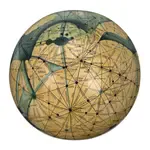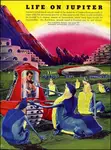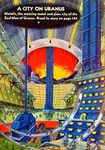a brief history of ooranye
22: the 'dassan call
[continued from 21: The Prospectors]

The Brown Smoke
Hovering like a Terrestrial eagle or a Uranian eopc over the landscape of Syoom, in what turned out to be the last days of the Thulium Era, we might have discerned murky caterpillar-shapes, fuzzy in outline, squirming across the plains. In doing so we would have witnessed one of the many phenomena grouped by historians under the title, “The Brown Smoke”.
Sooner or later it was bound to happen that the various non-human powers in Fyaym, in one of their periodic awakenings, should resent the incursions of the prospectors who had become ever bolder throughout the Thulium Era. The first serious attack of the “smoke” was aimed at Vyanth, the largest city of Syoom. The attack was beaten off, but the shock of that day triggered an eomasp which ushered in the 144 days, 13 hours of the Ytterbium Era – a time of disaster and of rescue.
The Lutetium Era
When a defence was invented against the Smoke – a device which reduced it to a shrinking bubbly patch of slime – the relief which this brought triggered yet another eomasp, which brought on the Lutetium Era.
Era 71 lasted 34,964 of the 30-hour Uranian days, plus 24 hours. This is equivalent to 119 and two-thirds Earth years – hardly longer than a single lifetime. Like the Nitrogen Era, it is one of the so-called “minor” eras with a historical importance out of proportion to its length.
It is in this period that the colloquial phrase “I am laying my life on the line” became – in the Nouuan tongue – compressed into a single long notorious word, kommassandassan.
It is a word spoken aloud only in very special situations, by someone so keen to alter a plan that nen is willing to risk nen’s life in order to interrupt proceedings. This is because custom – dating from Era 71 – has decreed that kommassandassan is a word of such power, that not only must it not be spoken in vain, but also it cannot be ignored, on pain of death in either case.
So if you feel that something must be stopped, you can cry ’dassan, and you will be heard; but if you are proved wrong in your reasons, or if you cannot convince, then you die. On the other hand if you are ignored but then turn out to have been right, then those who ignored you will die, no matter who they are.
The first time the ’dassan call was used, was at a muster of airships preparing to invade Fyaym on an expedition in retaliation for the Brown Smoke. A young officer, Gyan Ennye of Jaax, burst into the flagship control room and interrupted a meeting of the captains. Threatening them and the ship’s mechanisms with his laser, he at the same time pleaded so impressively for the mission to be called off, that they hesitated, and when he uttered the phrase, “I lay my life on the line”, they were sufficiently convinced that they postponed the fleet’s departure while they investigated his arguments.
As we all know, Gyan Ennye turned out to be right – the fleet would have been annihilated had it proceeded. The incident was never forgotten. It set the precedent for other occasions on which desperate individuals felt they had to halt some mighty process which would lead to disaster. What the institution of Corrector had done for the sunnoadex, the ’dassan call did for large movements in general.
However, on that first occasion near the beginning of Era 71, custom had not yet established the procedure of the Call in the form it has taken since then. Gyan Ennye had to wait long for vindication, even though his immediate warning was soon proved justified. The problem was, he had used violence, in order to get into the control room and to force the captains to listen to him.
He was court-martialled. The verdict was a strange one. Gross insubordination had occurred, and could not be denied. Yet after hundreds of precedents had been cited, dating from naval trials throughout the planet’s history, in the end the accused offered an unexpected deal, which his prosecutors decided to accept.
Simulation
Gyan Ennye was a member of the Dfangexcarj – the Simulator Project. This was a corporation recently formed to cultivate a machine (we would call it a giant semi-organic computer) that might aid in decision-making. Now it was agreed as part of the deal that the Simulator should be brought to bear on the question, “Should Syoom seek to punish the powers of Fyaym for the attack by the Brown Smoke?”
Hordes of wayfarers were sent out and data gathered as never before. The help of the Ghepions was sought and obtained. (They were all the more willing to help because they saw the Dfangexcarj as being potentially one of themselves.) Much opposition, however, was roused against the Project, for example among those who believed that successful Simulation would lead to too much certainty: thence a form of tyranny, and/or people becoming “soft”. But during the race against time to justify Gyan Ennye’s ’dassan call, a number of coups by Project supporters ensured that political support was kept alive. A sufficient quantity of intermediate predictions and simulations, some involving a certain amount of deceit, whetted the popular appetite for security in an uncertain age.
In the end, just as the agreed deadline was imminent, a particularly successful simulation was run. It completely vindicated Gyan Ennye’s advice. Verdict: Syoom ought to have a defence policy which really was defensive. It should not allow itself to get tempted into large-scale attacks on Fyaym; instead, reliance should be placed on mechanical prediction.
To the astonishment of many, Gyan Ennye himself seemed not quite happy with this conclusion. He wondered aloud whether it might be best to dismantle the Simulator! But he did not press the point; he became rather quiet, and embarked upon a subdued, low-profile existence.
Perhaps he was reassured by the fact that the great machine was allowed to fall into disuse, largely because of the difficulty and expense of keeping its expert system up to date.
The whole episode receded from people’s immediate concerns. Then, as if on cue, more trouble, more incursions from Fyaym, darkened the horizons and reminded people of how convenient a decider the Simulator had been. The last third of Era 71, therefore, saw a renewed interest in the process. Simulations, for purposes of disaster prediction as well as for aid in decision-making, became more popular than ever. Gyan Ennye was no longer alive by this time, but his success was very much in people’s minds. More ’dassan-calls were made and vindicated. Public opinion compelled the authorities to switch the original Simulator back on and to build others.
Finally the two ideas – Simulation and kommassandassan – came together when a Skyyonian Simulator, in the presence of the Sunnoad, proved by running two scenarios, one with and one without the institution of the ’dassan call, that the latter should be kept and codified as part of the culture.
On the same day, the same machine was used to recommend that all large-scale prospecting for crystals in Fyaym should stop. If that were to happen, Syoom must make up for the resource-lack by increased intelligence. The Simulators predicted who could supply this need:
Themselves.
The decision was left to the Sunnoad, Dynnt Gilvar 48559, who stood at a forking-point in history. His decision would establish which path Nennkind would follow for hundreds of lifetimes to come.
He chose to follow the Simulator’s advice. The news spread. Awareness of the implications spread, and a wave of emotion swept across Syoom.
Within hours it gathered sufficient force to cause an eomasp and the beginning of a new era, which turned out to be an age of stability and wisdom for a considerable while.





































